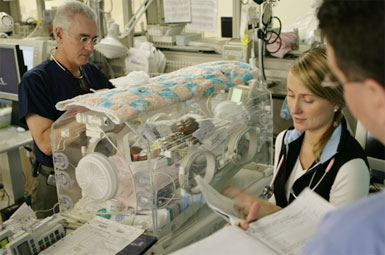While I am gradually being persuaded rocuronium might after all be a better choice than suxamethonium for rapid sequence intubation in critically ill patients- partly due to its relative preservation of apnoea time before desaturation in elective anaesthesia patients1 – I don’t believe that the existence and availability of its reversal agent, sugammadex, should really sway us in critical care. After all, we’re usually committed to getting an airway of some description (tracheal tube, supraglottic airway, or cricothyrotomy), and the relatively short duration of suxamethonium has never allowed me to ‘wake someone up and cancel the case’ in a critical care scenario. In fact, with sux, even healthy patients will desaturate before it wears off 2-4 if one is unable to intubate or ventilate.

But could we give sugammadex and reverse the rocuronium in time to save the patient in a can’t intubate/can’t ventilate (CICV) situation? This was tested in a simulation that studied the total time taken for anaesthetic teams to prepare and administer sugammadex from the time of their initial decision to use the drug5. The mean (SD) total time to administration of sugammadex was 6.7 (1.5) min, following which a further 2.2 min (giving a total 8.9 min) should be allowed to achieve a train-of-four ratio of 0.9. Four (22%) teams gave the correct dose, 10 (56%) teams gave a dose that was lower than recommended.
A reply to this article6 recommended some steps to speed up and improve the process:
- Brief the team that rocuronium is to be used and that should an unanticipated difficult airway situation be encountered, then sugammadex will be used to reverse the effects of the rocuronium.
- Allocate the task of drawing up the sugammadex to a specific team member who has no additional role in the rapid sequence induction.
- Before induction, a calculation is made of the dose of sugammadex (16 mg/kg) that would be required and the volume of drug that should be drawn up.
- The instruction is given that should the anaesthetist not confirm intubation within 2 min, then the sugammadex is to be drawn up and handed to the anaesthetist for administration.

There are of course rare situations where sugammadex can be a nuisance – it hangs around in renal failure and a recent case report 7described rocuronium (50mg followed by 30mg, patient weight not stated) failing to work on an elderly man who had received sugammadex 16 hours earlier! The authors of this case report state that in healthy patients, the mean cumulative percentage of sugammadex excreted in the urine over 24 h is 48–86%; therefore, a period of 24 h is recommended before a second administration of rocuronium. However, a good dose of rocuronium (1.2 mg/kg) should be effective after sugammadex reversal in previously healthy patients, but a study showed onset was slower and duration shorter if the second dose of rocuronium was given within 25 minutes of the sugammadex8.
So what are the take home points here? For me, the issues are:
- Suxamethonium offers no real advantages over rocuronium for RSI in critical care – rocuronium at a dose of 1.2 mg/kg will provide similar intubating conditions to a good dose of sux9
- Whatever you use, you need a rescue plan (supraglottic airway or transtracheal airway) for the CICV scenario
- Sugammadex is a useful reversal agent in elective anaesthesia but is unlikely to be useful in a critical care scenario; however, if its use is anticipated it needs to be rehearsed as a standardised drill
- Most of the literature on these agents pertains to well patients undergoing elective anaesthesia and we should be cautious about extrapolating results to the critical care setting
- Finally, the urgency of a CICV can be reduced by CICVBCO – ‘can’t intubate, can’t ventilate, but CAN oxygenate’ – apnoeic diffusion oxygenation should be employed using pharyngeal or nasal oxygen10. Such a simple but underutilised technique can hugely improve the safety of RSI in critical care, and is described here.
1. Effect of suxamethonium vs rocuronium on onset of oxygen desaturation during apnoea following rapid sequence induction
Anaesthesia. 2010 Apr;65(4):358-61
2. Critical hemoglobin desaturation will occur before return to an unparalyzed state following 1 mg/kg intravenous succinylcholine.
Anesthesiology. 1997 Oct;87(4):979-8
3. Hemoglobin desaturation after succinylcholine-induced apnea: a study of the recovery of spontaneous ventilation in healthy volunteers.
Anesthesiology. 2001 May;94(5):754-9
4. Succinylcholine dosage and apnea-induced hemoglobin desaturation in patients
Anesthesiology. 2005 Jan;102(1):35-40
5. Can sugammadex save a patient in a simulated ‘cannot intubate, cannot ventilate’ situation?
Anaesthesia. 2010 Sep;65(9):936-41
6. Can sugammadex save a patient in a simulated ‘cannot intubate, cannot ventilate’ situation?
Anaesthesia. 2011 Mar;66(3):223-4
7. Unexpected failure of rocuronium-mediated neuromuscular blockade
Anaesthesia. 2011 Jan;66(1):58-9
8. Repeat dosing of rocuronium 1.2 mg kg−1 after reversal of neuromuscular block by sugammadex 4.0 mg kg−1 in anaesthetized healthy volunteers: a modelling-based pilot study
Br J Anaesth. 2010 Oct;105(4):487-92
9. Comparison of Succinylcholine and Rocuronium for First-attempt Intubation Success in the Emergency Department
Acad Emerg Med. 2011;18:11-14
10. Critical hemoglobin desaturation can be delayed by apneic diffusion oxygenation
Anesthesiology. 1999 Jan;90(1):332-3

 ABSTRACT
ABSTRACT






